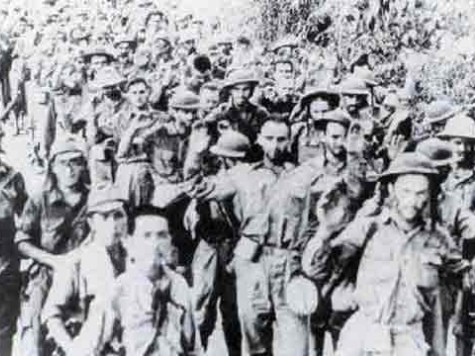
The following begins a series in five parts based on questions that arise from integrating revelations of intelligence history – specifically, the influence on US policy-making by Americans acting on the Kremlin’s behalf– into the well-known sequence of World War II events. These questions are discussed and documented extensively in the new book American Betrayal: The Secret Assault on Our Nation’s Character (St. Martin’s Press) by Diana West.
Japan attacked Pearl Harbor on Dec. 7, 1941. It is a day that still lives in infamy, just as FDR predicted.
According to Soviet intelligence reports, we now know that one of FDR’s top officials, the Treasury Department’s Harry Dexter White, was a Soviet agent, who, among many other deceptions, subverted relations between the US and Japan by inserting “ultimatum” language into the cable flow that actually spurred the Japanese attack. This was language written in Moscow, passed to White by a Soviet handler in Washington, D.C., and dropped into a State Department communiqué sent to Japan.
This brilliantly executed influence operation doesn’t live in infamy – at least not yet. Along with other shocking intelligence findings about American agents of the Kremlin, it hasn’t been accepted into the general historical narrative. This weaving of the intelligence record into the historical narrative is the mechanism that propels American Betrayal.
On Dec. 8, 1941, Japan attacked the Philippines, defended by Gen. MacArthur and 151,000 US and Filipino troops.
This date doesn’t live in infamy, either. For the next seven months, however, until the last troops surrendered to Japan, Americans and Filipinos withstood deadly, punishing siege, as the record of loss and suffering at Corregidor, Bataan, and the Bataan Death March attests. Ten thousand troops were killed at Bataan alone. Shockingly, these forces didn’t receive relief from the US from the day of attack to the day of surrender.
Nor did they receive any assistance from our Soviet “ally,” which observed its neutrality treaty with Japan until one fateful land-grabbing week in August 1945.
“A continuous stream of fighter and pursuit planes is traversing the Pacific,” FDR cabled MacArthur is early 1942, one of the extravagant lies FDR told to the people and forces under Japanese siege. No planes were on their way. Nothing was coming. But little wonder MacArthur ordered bulldozers to work around the clock to carve out four airstrips in the central Philippines and nine on Mindanao in expectation. Truth, John Hersey later wrote, would come “in mean little doses.”
Meanwhile, the heavy flow of arms and material to Britain and the Soviet Union continued under Lend Lease, the massive program engineered by the Roosevelt White House to supply America’s allies including, controversially, Stalin. “I would go out and take the stuff off the shelves of the stores and pay them any price necessary, and put it in a truck and rush it to the boat,” FDR said to Treasury Secretary Henry Morgenthau on March 11, 1942. “Nothing would be worse than to have the Russians collapse.”
Nothing? How about the collapse of those 151,000 American and Filipino troops who, at this touching moment of solicitude in the Oval Office for the Red Army, had just begun their fourth month of unreinforced, unsupplied, death-defying resistance to Japanese assault?
Is there something wrong with this picture – something we have failed to notice over all these years?
For the first 24 hours after Japan attacked, US military officials did reverse the flow of arms, aircraft and ammunition heading for England and the USSR for re-shipment to Hawaii and the Philippines – the patriotic reaction, the natural reaction. This, however, would be overruled from the top, as Lend Lease historian George C. Herring has noted.
Why? Why wasn’t supplying US forces fighting Japanese in the Philippines taking immediate precedent over supplying Soviet forces fighting Germans in the USSR? Was this decision not to relieve our men being pounded at Corregidor and Bataan the terrible but unavoidable price of a winning strategy, as Americans have been taught? After all, the US and Britain, conspiring (the US was still neutral) before Pearl Harbor to combine forces to defeat Hitler, had settled on a Europe-first strategy to defeat the Axis powers: Nazi Germany, first; then, Imperial Japan. According to the hardened narrative, the Japanese attacks on Pearl Harbor and the Philippines changed nothing.
Meanwhile, the same conventional wisdom has it, there were insufficient resources and too much risk involved in sending relief to MacArthur.
The general didn’t agree. Twenty years after the event, MacArthur wrote in his memoir Reminiscences that he believed the Navy had “deprecated its own strength and might well have cut through to relieve our hard-pressed forces. The bulk of the Jap Navy was headed south to seize Borneo, Malaya, and Indo-China. American carriers having escaped destruction at Pearl Harbor could have brought planes to the Philippines. The Navy fought the next two years and had great victories without any new ships.”
Meanwhile, the US continued to sustain catastrophic losses while shipping Lend Lease supplies to Stalin through the Nazi U-boat-infested North Atlantic.
Could the decision to abandon US forces to death or the horrors of Japanese POW camps by giving uninterrupted priority to the Red Army have had anything to do with the influence of the scores of Soviet agents and assets within reach of the levers of power inside the US government? How about the man driving military supply policy, the man behind Lend Lease?
That man was Harry Hopkins and he was without question FDR’s top wartime advisor. As George Marshall would state in 1957 to his official biographer Forrest Pogue: “Hopkins’s job with the president was to represent the Russian interests. My job was to represent the American interests.”
Was Hopkins representing Russian interests at a time of American need?
Who was Harry Hopkins?
Part 2 will appear tomorrow.
Diana West is the author of American Betrayal: The Secret Assault on Our Nation’s Character

COMMENTS
Please let us know if you're having issues with commenting.